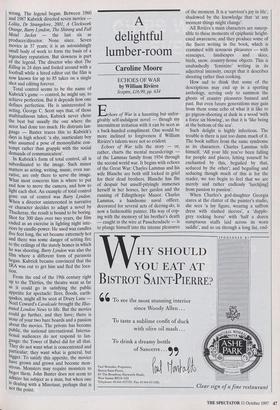Total control takes longer
John Bowen
STANLEY KUBRICK by John Baxter HarperCollins, £20, pp. 399
The set of a Kubrick movie does not seem to have been a happy place. No jokes, not even on Dr Strangelove. If there were, the associate producer would be sent to say, 'Stanley doesn't like it when people are laughing.' They're a funny lot, film directors, hardly human beings at all.
Common to all Kubrick films is a meticu- lous control of the image, as if a still photo- graph, with every element arranged, is then animated into a carefully controlled move- ment. This, John Baxter suggests, is because Kubrick began as a photo-journal- ist for Look magazine. Soon he decided that he had mastered photo-journalism; there was no more to learn. Movies were an obvious way to extend that mastery. But first he would have to work out how it was done. During his early days in Greenwich Village from the late Forties to early Fifties, Kubrick saw every daily change of programme at the Museum of Modern Art's film theatre. Unaffected by such extraneous matters as the emotional or moral content of what he saw, he learned by analysis how movies were made.
A photograph animated into movement . . . Prizefighter, a piece of his photo-jour- nalism for Look, published in 1949, about a day in the life of a middle-weight boxer, became a 30-minute documentary, Day of the Fight, in 1951.
At first he worked relatively quickly. Between 1951 and 1956 there were two more documentaries, a five-part series for television, two quasi-poetic, symbolist, pri- vately financed movies and a B-movie, The Killing, shot in 24 days. Then, in 1957, Paths of Glory for United Artists, with Kirk Douglas starring. The Kubrick canon had begun. In 1959 Douglas hired him to replace Anthony Mann as the director of Spartacus.
Thereafter it all went right and it all went wrong. The legend began. Between 1960 and 1987 Kubrick directed seven movies — Lolita, Dr Strangelove, 2001, A Clockwork Orange, Barry Lyndon, The Shining and Full Metal Jacket — the last six as producer/director. None since. Seven movies in 37 years; it is an astonishingly small body of work to form the basis of a legendary reputation. But slowness is part of the legend. The director who shot The Killing in 24 days and fooled around with a football while a hired editor cut the film is now known for up to 85 takes on a single shot and editing forever. Total control seems to be the name of Kubrick's game — control, he might say, to achieve perfection. But it depends how one defines perfection. He is uninterested in acting. George C. Scott says that, of those multitudinous takes, Kubrick never chose the best but usually the one where the actor had done too much. He distrusts lan- guage — Baxter traces this to Kubrick's days in high school: 'a shy, inarticulate boy Who assumed a pose of monosyllabic con- tempt rather than grapple with the social demands of communication'.
In Kubrick's form of total control, all is subordinated to the image. Such minor matters as acting, writing, music, even nar- rative, are only there to serve the image. What most concerns him is where to put and how to move the camera, and how to light each shot. An example of total control gone out of control was Barry Lyndon. When a director uninterested in narrative or character decides to adapt a novel by Thackeray, the result is bound to be boring. Shot for 300 days over two years, the film ended as an exercise in lighting night inte- riors by candle-power. He used wax candles five feet long, the set became extremely hot and there was some danger of setting fire to the ceilings of the stately homes in which he was shooting. Barry Lyndon was also the film where a different form of paranoia began. Kubrick became convinced that the IRA was out to get him and fled the loca- tion.
From the end of the 19th century right UP to the Thirties, the theatre went as far aS it could go in satisfying the public appetite for spectacle: fires, floods, earth- quakes, might all be seen at Drury Lane — Noel Coward's Cavalcade brought the Illus- trated London News to life. But the movies could go further, and they have; there is none of your two bare boards and a passion about the movies. The private has become Public, the national international. Interna- tional audiences do not respond to lan- guage: the Tower of Babel did for all that. They do not want what is concentrated and particular; they want what is general, but bigger. To satisfy this appetite, the movies have grown and grown and become mon- strous. Monsters may require monsters to beget them. John Baxter does not seem to admire his subject as a man, but when one is dealing with a Minotaur, perhaps that is not the point.



















































































 Previous page
Previous page